HI6028 Taxation Assignment: CGT, GST, and Australian Tax Law Analysis
VerifiedAdded on 2022/10/10
|11
|2243
|89
Homework Assignment
AI Summary
This document presents a detailed solution to a taxation assignment focusing on Goods and Services Tax (GST) and Capital Gains Tax (CGT) within the Australian context. The assignment addresses two primary issues: the eligibility of City Sky Limited for input tax credit and the CGT implications for Emma based on several transactions. The GST section analyzes the company's entitlement to input tax credits, calculating the creditable acquisition and the GST amount. The CGT section explores Emma's tax liabilities arising from the sale of land, shares, and other assets, calculating the cost base, capital proceeds, and the resulting CGT gain or loss, considering relevant elements like stamp duty, legal fees, and various expenses. The solution applies relevant sections of the GST Act 1999 and the Income Tax Assessment Act 1997, providing calculations and conclusions for each scenario. The document offers a comprehensive analysis of the taxation principles, calculations, and implications of CGT and GST in the given scenarios.
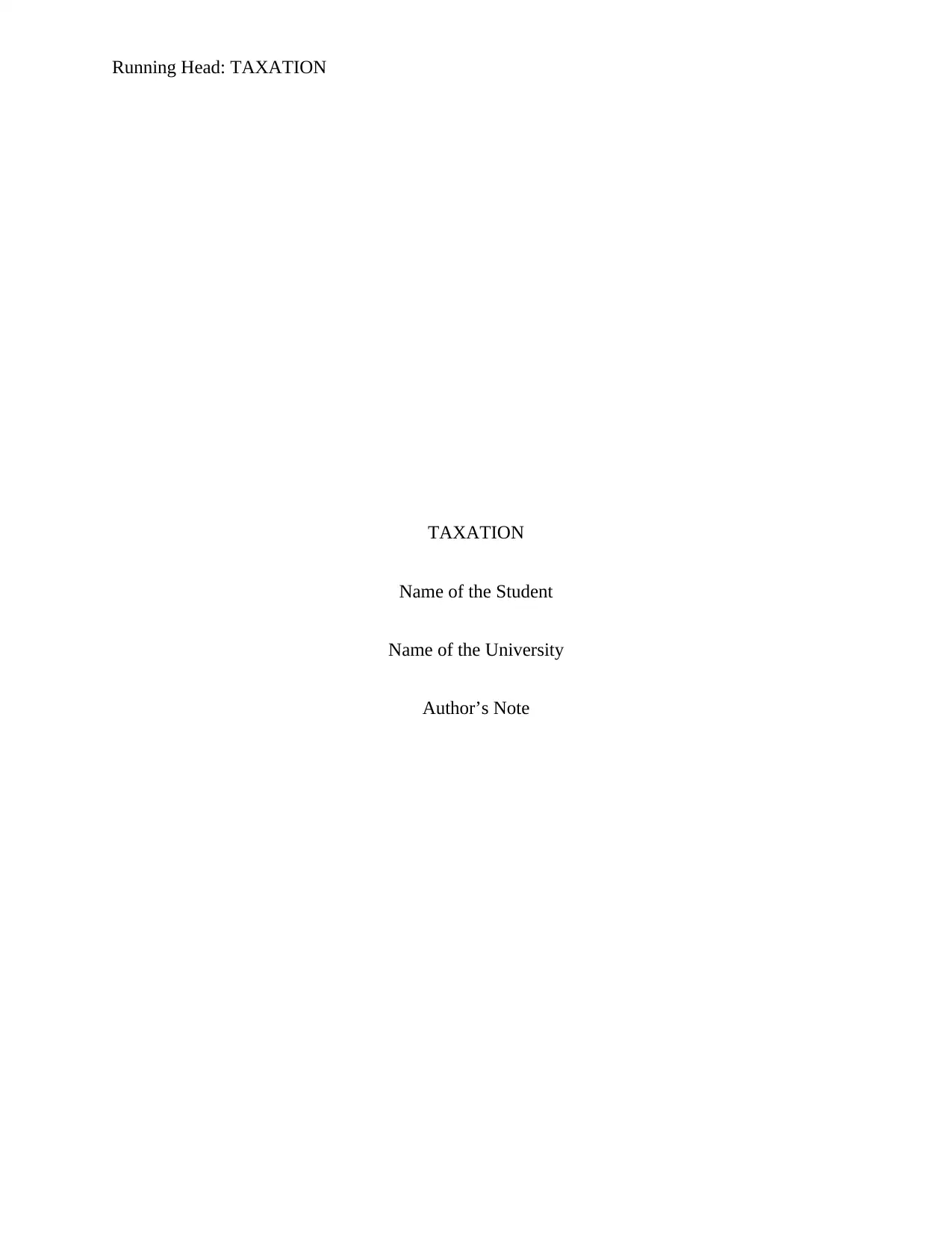
Running Head: TAXATION
TAXATION
Name of the Student
Name of the University
Author’s Note
TAXATION
Name of the Student
Name of the University
Author’s Note
Paraphrase This Document
Need a fresh take? Get an instant paraphrase of this document with our AI Paraphraser
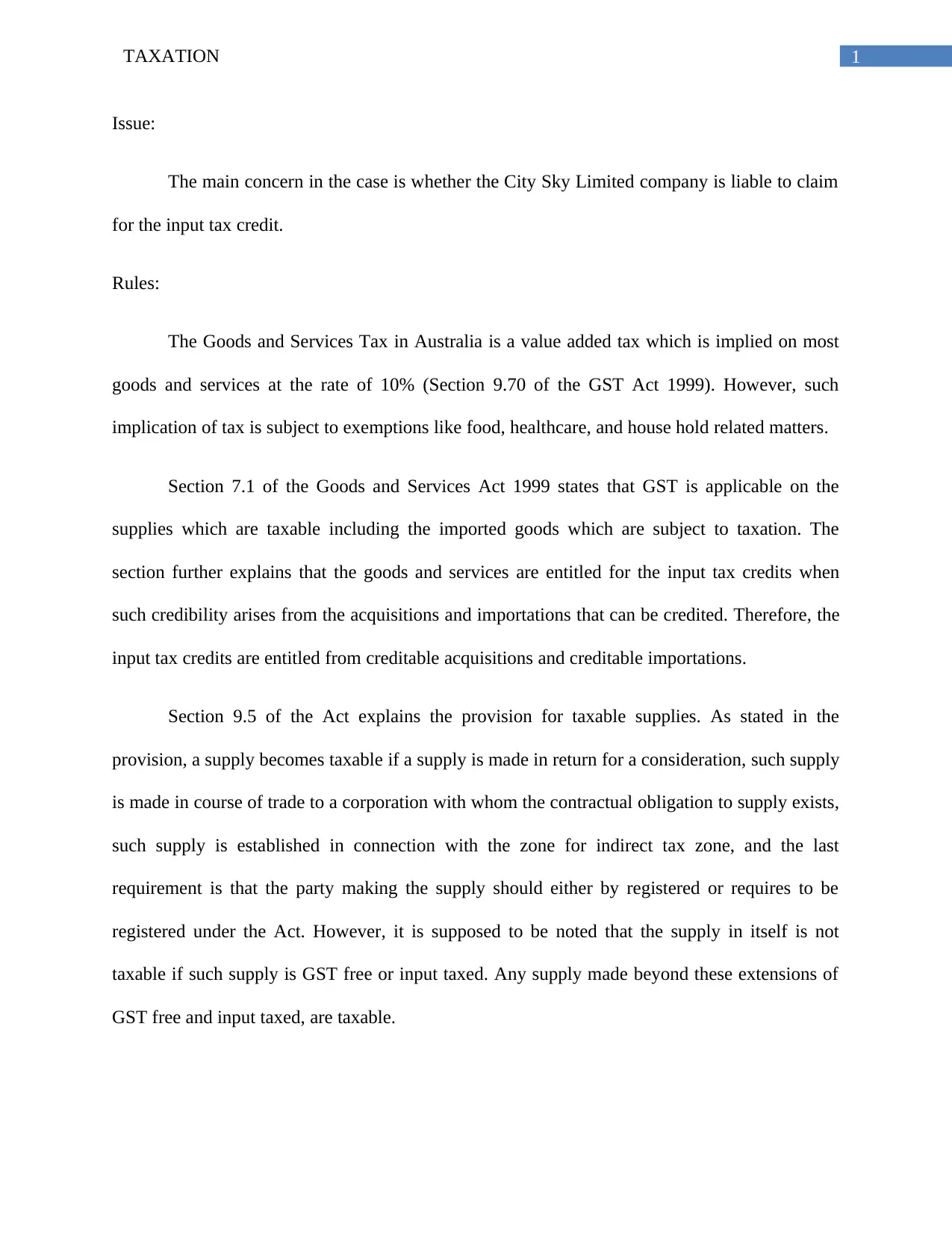
1TAXATION
Issue:
The main concern in the case is whether the City Sky Limited company is liable to claim
for the input tax credit.
Rules:
The Goods and Services Tax in Australia is a value added tax which is implied on most
goods and services at the rate of 10% (Section 9.70 of the GST Act 1999). However, such
implication of tax is subject to exemptions like food, healthcare, and house hold related matters.
Section 7.1 of the Goods and Services Act 1999 states that GST is applicable on the
supplies which are taxable including the imported goods which are subject to taxation. The
section further explains that the goods and services are entitled for the input tax credits when
such credibility arises from the acquisitions and importations that can be credited. Therefore, the
input tax credits are entitled from creditable acquisitions and creditable importations.
Section 9.5 of the Act explains the provision for taxable supplies. As stated in the
provision, a supply becomes taxable if a supply is made in return for a consideration, such supply
is made in course of trade to a corporation with whom the contractual obligation to supply exists,
such supply is established in connection with the zone for indirect tax zone, and the last
requirement is that the party making the supply should either by registered or requires to be
registered under the Act. However, it is supposed to be noted that the supply in itself is not
taxable if such supply is GST free or input taxed. Any supply made beyond these extensions of
GST free and input taxed, are taxable.
Issue:
The main concern in the case is whether the City Sky Limited company is liable to claim
for the input tax credit.
Rules:
The Goods and Services Tax in Australia is a value added tax which is implied on most
goods and services at the rate of 10% (Section 9.70 of the GST Act 1999). However, such
implication of tax is subject to exemptions like food, healthcare, and house hold related matters.
Section 7.1 of the Goods and Services Act 1999 states that GST is applicable on the
supplies which are taxable including the imported goods which are subject to taxation. The
section further explains that the goods and services are entitled for the input tax credits when
such credibility arises from the acquisitions and importations that can be credited. Therefore, the
input tax credits are entitled from creditable acquisitions and creditable importations.
Section 9.5 of the Act explains the provision for taxable supplies. As stated in the
provision, a supply becomes taxable if a supply is made in return for a consideration, such supply
is made in course of trade to a corporation with whom the contractual obligation to supply exists,
such supply is established in connection with the zone for indirect tax zone, and the last
requirement is that the party making the supply should either by registered or requires to be
registered under the Act. However, it is supposed to be noted that the supply in itself is not
taxable if such supply is GST free or input taxed. Any supply made beyond these extensions of
GST free and input taxed, are taxable.
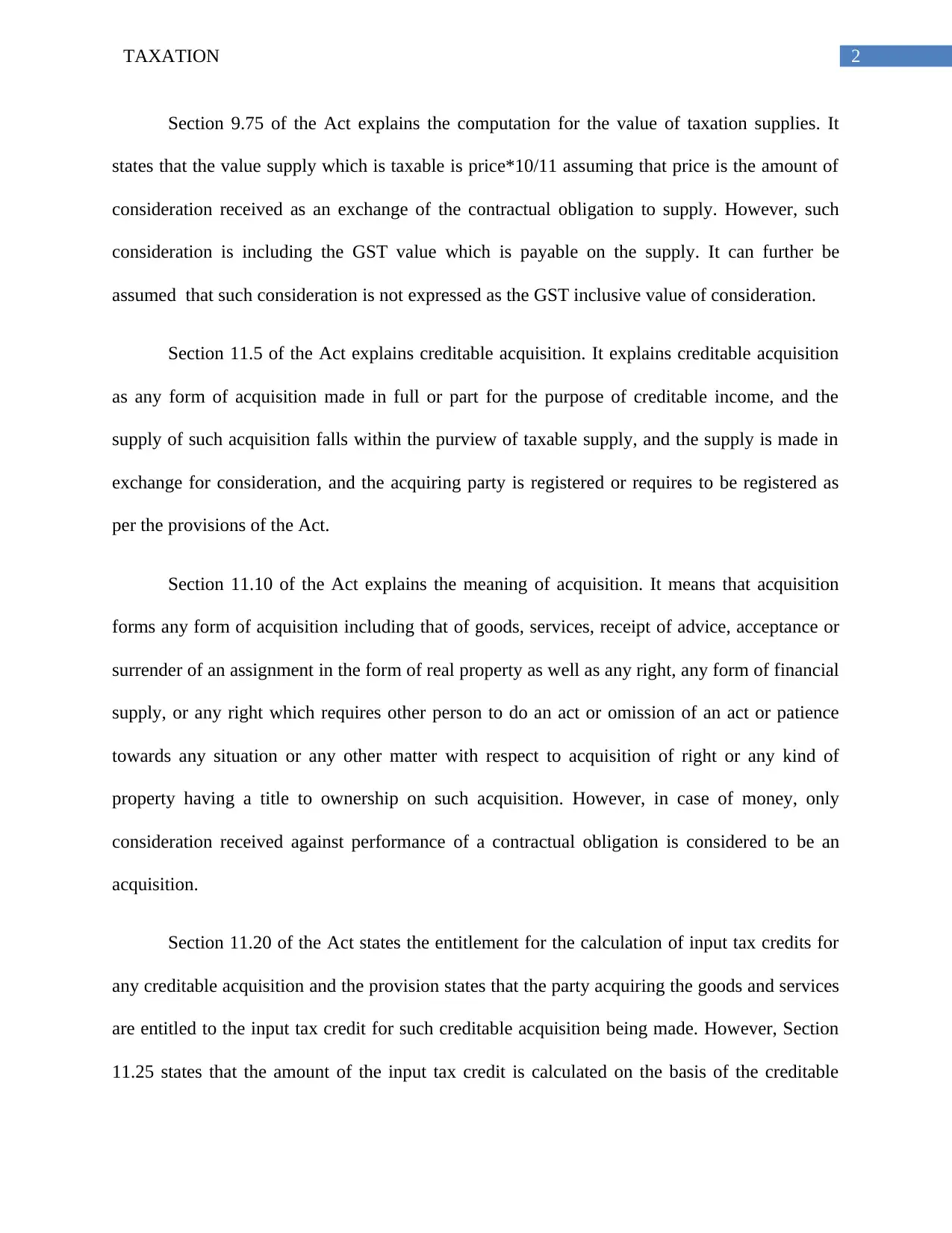
2TAXATION
Section 9.75 of the Act explains the computation for the value of taxation supplies. It
states that the value supply which is taxable is price*10/11 assuming that price is the amount of
consideration received as an exchange of the contractual obligation to supply. However, such
consideration is including the GST value which is payable on the supply. It can further be
assumed that such consideration is not expressed as the GST inclusive value of consideration.
Section 11.5 of the Act explains creditable acquisition. It explains creditable acquisition
as any form of acquisition made in full or part for the purpose of creditable income, and the
supply of such acquisition falls within the purview of taxable supply, and the supply is made in
exchange for consideration, and the acquiring party is registered or requires to be registered as
per the provisions of the Act.
Section 11.10 of the Act explains the meaning of acquisition. It means that acquisition
forms any form of acquisition including that of goods, services, receipt of advice, acceptance or
surrender of an assignment in the form of real property as well as any right, any form of financial
supply, or any right which requires other person to do an act or omission of an act or patience
towards any situation or any other matter with respect to acquisition of right or any kind of
property having a title to ownership on such acquisition. However, in case of money, only
consideration received against performance of a contractual obligation is considered to be an
acquisition.
Section 11.20 of the Act states the entitlement for the calculation of input tax credits for
any creditable acquisition and the provision states that the party acquiring the goods and services
are entitled to the input tax credit for such creditable acquisition being made. However, Section
11.25 states that the amount of the input tax credit is calculated on the basis of the creditable
Section 9.75 of the Act explains the computation for the value of taxation supplies. It
states that the value supply which is taxable is price*10/11 assuming that price is the amount of
consideration received as an exchange of the contractual obligation to supply. However, such
consideration is including the GST value which is payable on the supply. It can further be
assumed that such consideration is not expressed as the GST inclusive value of consideration.
Section 11.5 of the Act explains creditable acquisition. It explains creditable acquisition
as any form of acquisition made in full or part for the purpose of creditable income, and the
supply of such acquisition falls within the purview of taxable supply, and the supply is made in
exchange for consideration, and the acquiring party is registered or requires to be registered as
per the provisions of the Act.
Section 11.10 of the Act explains the meaning of acquisition. It means that acquisition
forms any form of acquisition including that of goods, services, receipt of advice, acceptance or
surrender of an assignment in the form of real property as well as any right, any form of financial
supply, or any right which requires other person to do an act or omission of an act or patience
towards any situation or any other matter with respect to acquisition of right or any kind of
property having a title to ownership on such acquisition. However, in case of money, only
consideration received against performance of a contractual obligation is considered to be an
acquisition.
Section 11.20 of the Act states the entitlement for the calculation of input tax credits for
any creditable acquisition and the provision states that the party acquiring the goods and services
are entitled to the input tax credit for such creditable acquisition being made. However, Section
11.25 states that the amount of the input tax credit is calculated on the basis of the creditable
⊘ This is a preview!⊘
Do you want full access?
Subscribe today to unlock all pages.

Trusted by 1+ million students worldwide
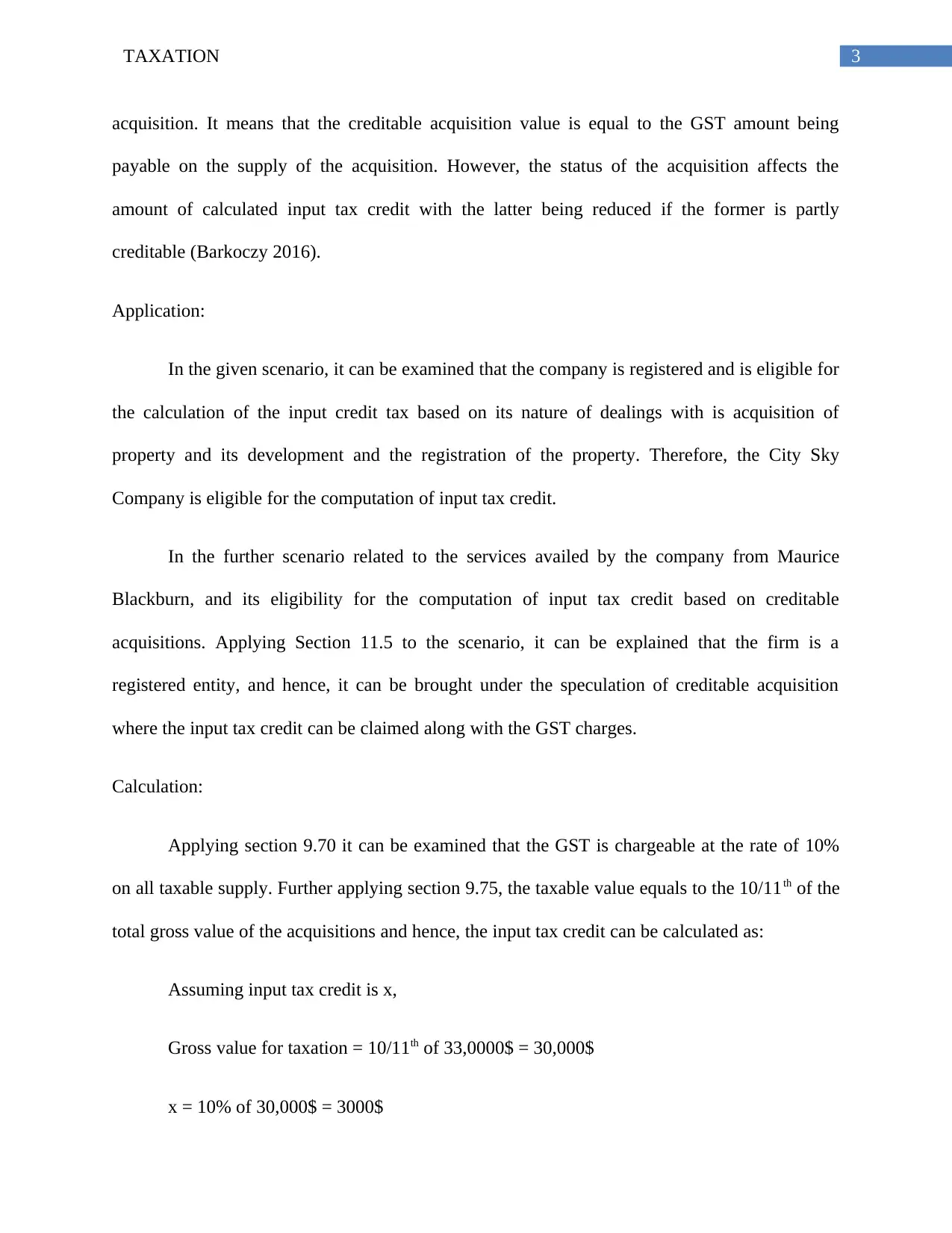
3TAXATION
acquisition. It means that the creditable acquisition value is equal to the GST amount being
payable on the supply of the acquisition. However, the status of the acquisition affects the
amount of calculated input tax credit with the latter being reduced if the former is partly
creditable (Barkoczy 2016).
Application:
In the given scenario, it can be examined that the company is registered and is eligible for
the calculation of the input credit tax based on its nature of dealings with is acquisition of
property and its development and the registration of the property. Therefore, the City Sky
Company is eligible for the computation of input tax credit.
In the further scenario related to the services availed by the company from Maurice
Blackburn, and its eligibility for the computation of input tax credit based on creditable
acquisitions. Applying Section 11.5 to the scenario, it can be explained that the firm is a
registered entity, and hence, it can be brought under the speculation of creditable acquisition
where the input tax credit can be claimed along with the GST charges.
Calculation:
Applying section 9.70 it can be examined that the GST is chargeable at the rate of 10%
on all taxable supply. Further applying section 9.75, the taxable value equals to the 10/11th of the
total gross value of the acquisitions and hence, the input tax credit can be calculated as:
Assuming input tax credit is x,
Gross value for taxation = 10/11th of 33,0000$ = 30,000$
x = 10% of 30,000$ = 3000$
acquisition. It means that the creditable acquisition value is equal to the GST amount being
payable on the supply of the acquisition. However, the status of the acquisition affects the
amount of calculated input tax credit with the latter being reduced if the former is partly
creditable (Barkoczy 2016).
Application:
In the given scenario, it can be examined that the company is registered and is eligible for
the calculation of the input credit tax based on its nature of dealings with is acquisition of
property and its development and the registration of the property. Therefore, the City Sky
Company is eligible for the computation of input tax credit.
In the further scenario related to the services availed by the company from Maurice
Blackburn, and its eligibility for the computation of input tax credit based on creditable
acquisitions. Applying Section 11.5 to the scenario, it can be explained that the firm is a
registered entity, and hence, it can be brought under the speculation of creditable acquisition
where the input tax credit can be claimed along with the GST charges.
Calculation:
Applying section 9.70 it can be examined that the GST is chargeable at the rate of 10%
on all taxable supply. Further applying section 9.75, the taxable value equals to the 10/11th of the
total gross value of the acquisitions and hence, the input tax credit can be calculated as:
Assuming input tax credit is x,
Gross value for taxation = 10/11th of 33,0000$ = 30,000$
x = 10% of 30,000$ = 3000$
Paraphrase This Document
Need a fresh take? Get an instant paraphrase of this document with our AI Paraphraser
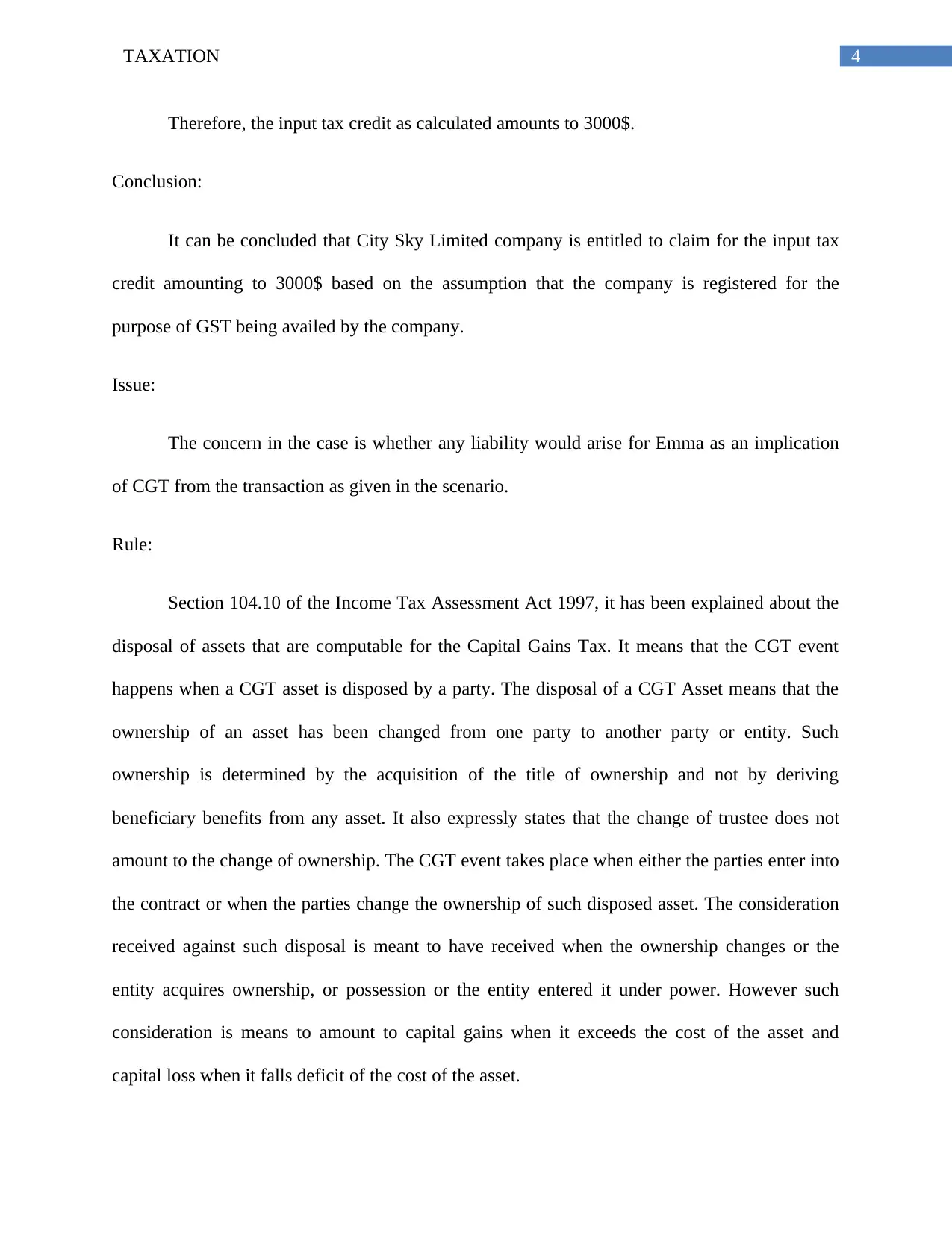
4TAXATION
Therefore, the input tax credit as calculated amounts to 3000$.
Conclusion:
It can be concluded that City Sky Limited company is entitled to claim for the input tax
credit amounting to 3000$ based on the assumption that the company is registered for the
purpose of GST being availed by the company.
Issue:
The concern in the case is whether any liability would arise for Emma as an implication
of CGT from the transaction as given in the scenario.
Rule:
Section 104.10 of the Income Tax Assessment Act 1997, it has been explained about the
disposal of assets that are computable for the Capital Gains Tax. It means that the CGT event
happens when a CGT asset is disposed by a party. The disposal of a CGT Asset means that the
ownership of an asset has been changed from one party to another party or entity. Such
ownership is determined by the acquisition of the title of ownership and not by deriving
beneficiary benefits from any asset. It also expressly states that the change of trustee does not
amount to the change of ownership. The CGT event takes place when either the parties enter into
the contract or when the parties change the ownership of such disposed asset. The consideration
received against such disposal is meant to have received when the ownership changes or the
entity acquires ownership, or possession or the entity entered it under power. However such
consideration is means to amount to capital gains when it exceeds the cost of the asset and
capital loss when it falls deficit of the cost of the asset.
Therefore, the input tax credit as calculated amounts to 3000$.
Conclusion:
It can be concluded that City Sky Limited company is entitled to claim for the input tax
credit amounting to 3000$ based on the assumption that the company is registered for the
purpose of GST being availed by the company.
Issue:
The concern in the case is whether any liability would arise for Emma as an implication
of CGT from the transaction as given in the scenario.
Rule:
Section 104.10 of the Income Tax Assessment Act 1997, it has been explained about the
disposal of assets that are computable for the Capital Gains Tax. It means that the CGT event
happens when a CGT asset is disposed by a party. The disposal of a CGT Asset means that the
ownership of an asset has been changed from one party to another party or entity. Such
ownership is determined by the acquisition of the title of ownership and not by deriving
beneficiary benefits from any asset. It also expressly states that the change of trustee does not
amount to the change of ownership. The CGT event takes place when either the parties enter into
the contract or when the parties change the ownership of such disposed asset. The consideration
received against such disposal is meant to have received when the ownership changes or the
entity acquires ownership, or possession or the entity entered it under power. However such
consideration is means to amount to capital gains when it exceeds the cost of the asset and
capital loss when it falls deficit of the cost of the asset.
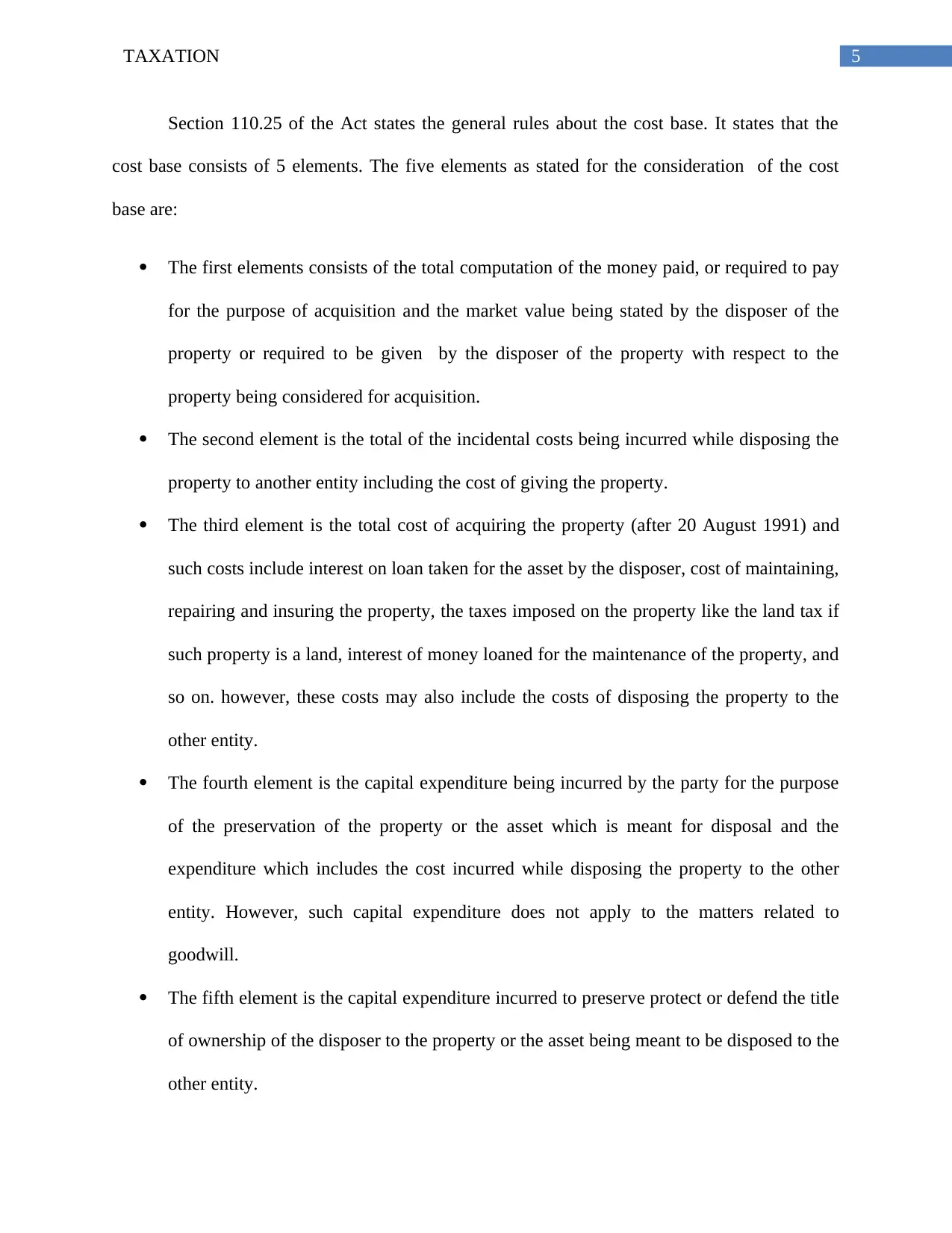
5TAXATION
Section 110.25 of the Act states the general rules about the cost base. It states that the
cost base consists of 5 elements. The five elements as stated for the consideration of the cost
base are:
The first elements consists of the total computation of the money paid, or required to pay
for the purpose of acquisition and the market value being stated by the disposer of the
property or required to be given by the disposer of the property with respect to the
property being considered for acquisition.
The second element is the total of the incidental costs being incurred while disposing the
property to another entity including the cost of giving the property.
The third element is the total cost of acquiring the property (after 20 August 1991) and
such costs include interest on loan taken for the asset by the disposer, cost of maintaining,
repairing and insuring the property, the taxes imposed on the property like the land tax if
such property is a land, interest of money loaned for the maintenance of the property, and
so on. however, these costs may also include the costs of disposing the property to the
other entity.
The fourth element is the capital expenditure being incurred by the party for the purpose
of the preservation of the property or the asset which is meant for disposal and the
expenditure which includes the cost incurred while disposing the property to the other
entity. However, such capital expenditure does not apply to the matters related to
goodwill.
The fifth element is the capital expenditure incurred to preserve protect or defend the title
of ownership of the disposer to the property or the asset being meant to be disposed to the
other entity.
Section 110.25 of the Act states the general rules about the cost base. It states that the
cost base consists of 5 elements. The five elements as stated for the consideration of the cost
base are:
The first elements consists of the total computation of the money paid, or required to pay
for the purpose of acquisition and the market value being stated by the disposer of the
property or required to be given by the disposer of the property with respect to the
property being considered for acquisition.
The second element is the total of the incidental costs being incurred while disposing the
property to another entity including the cost of giving the property.
The third element is the total cost of acquiring the property (after 20 August 1991) and
such costs include interest on loan taken for the asset by the disposer, cost of maintaining,
repairing and insuring the property, the taxes imposed on the property like the land tax if
such property is a land, interest of money loaned for the maintenance of the property, and
so on. however, these costs may also include the costs of disposing the property to the
other entity.
The fourth element is the capital expenditure being incurred by the party for the purpose
of the preservation of the property or the asset which is meant for disposal and the
expenditure which includes the cost incurred while disposing the property to the other
entity. However, such capital expenditure does not apply to the matters related to
goodwill.
The fifth element is the capital expenditure incurred to preserve protect or defend the title
of ownership of the disposer to the property or the asset being meant to be disposed to the
other entity.
⊘ This is a preview!⊘
Do you want full access?
Subscribe today to unlock all pages.

Trusted by 1+ million students worldwide
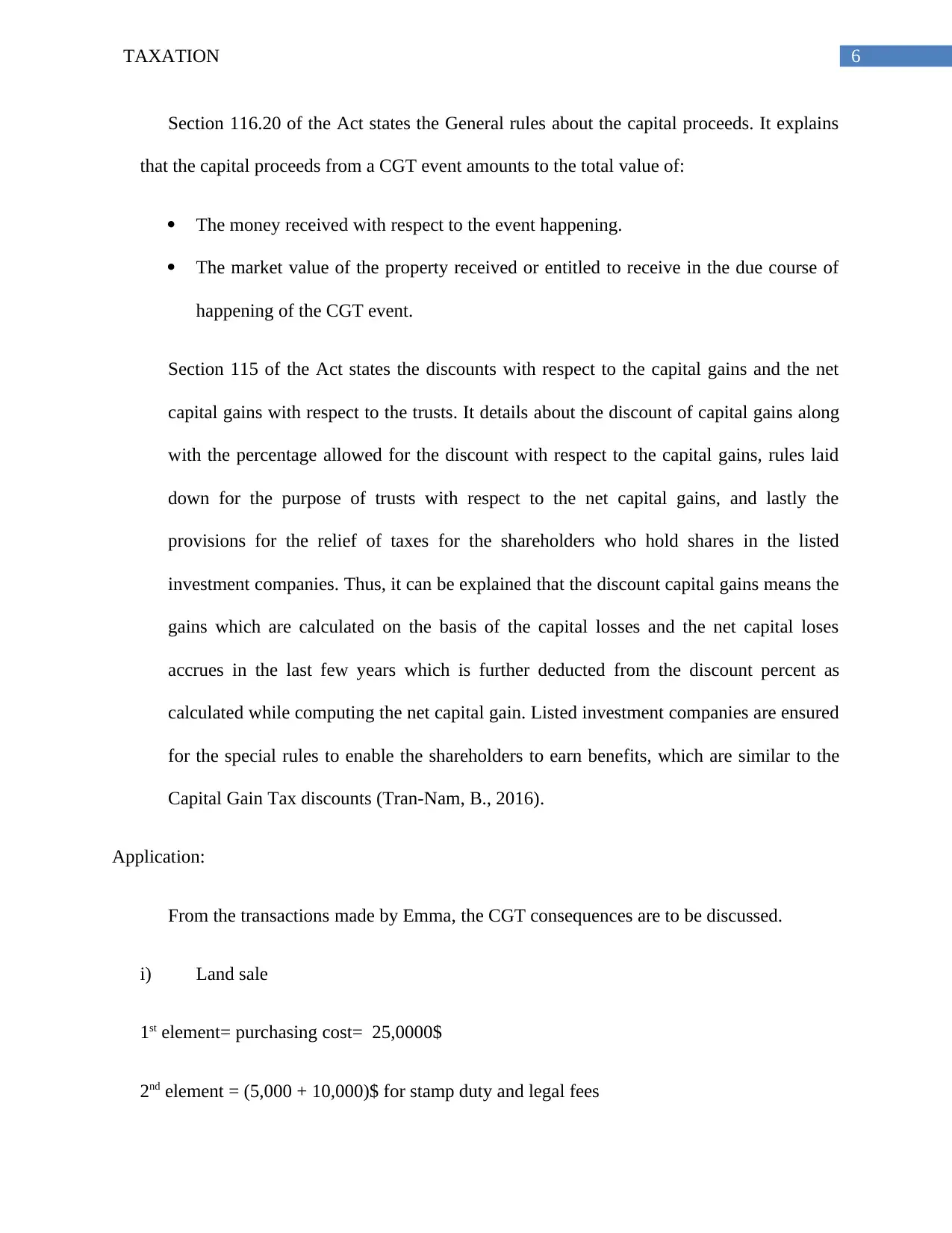
6TAXATION
Section 116.20 of the Act states the General rules about the capital proceeds. It explains
that the capital proceeds from a CGT event amounts to the total value of:
The money received with respect to the event happening.
The market value of the property received or entitled to receive in the due course of
happening of the CGT event.
Section 115 of the Act states the discounts with respect to the capital gains and the net
capital gains with respect to the trusts. It details about the discount of capital gains along
with the percentage allowed for the discount with respect to the capital gains, rules laid
down for the purpose of trusts with respect to the net capital gains, and lastly the
provisions for the relief of taxes for the shareholders who hold shares in the listed
investment companies. Thus, it can be explained that the discount capital gains means the
gains which are calculated on the basis of the capital losses and the net capital loses
accrues in the last few years which is further deducted from the discount percent as
calculated while computing the net capital gain. Listed investment companies are ensured
for the special rules to enable the shareholders to earn benefits, which are similar to the
Capital Gain Tax discounts (Tran-Nam, B., 2016).
Application:
From the transactions made by Emma, the CGT consequences are to be discussed.
i) Land sale
1st element= purchasing cost= 25,0000$
2nd element = (5,000 + 10,000)$ for stamp duty and legal fees
Section 116.20 of the Act states the General rules about the capital proceeds. It explains
that the capital proceeds from a CGT event amounts to the total value of:
The money received with respect to the event happening.
The market value of the property received or entitled to receive in the due course of
happening of the CGT event.
Section 115 of the Act states the discounts with respect to the capital gains and the net
capital gains with respect to the trusts. It details about the discount of capital gains along
with the percentage allowed for the discount with respect to the capital gains, rules laid
down for the purpose of trusts with respect to the net capital gains, and lastly the
provisions for the relief of taxes for the shareholders who hold shares in the listed
investment companies. Thus, it can be explained that the discount capital gains means the
gains which are calculated on the basis of the capital losses and the net capital loses
accrues in the last few years which is further deducted from the discount percent as
calculated while computing the net capital gain. Listed investment companies are ensured
for the special rules to enable the shareholders to earn benefits, which are similar to the
Capital Gain Tax discounts (Tran-Nam, B., 2016).
Application:
From the transactions made by Emma, the CGT consequences are to be discussed.
i) Land sale
1st element= purchasing cost= 25,0000$
2nd element = (5,000 + 10,000)$ for stamp duty and legal fees
Paraphrase This Document
Need a fresh take? Get an instant paraphrase of this document with our AI Paraphraser
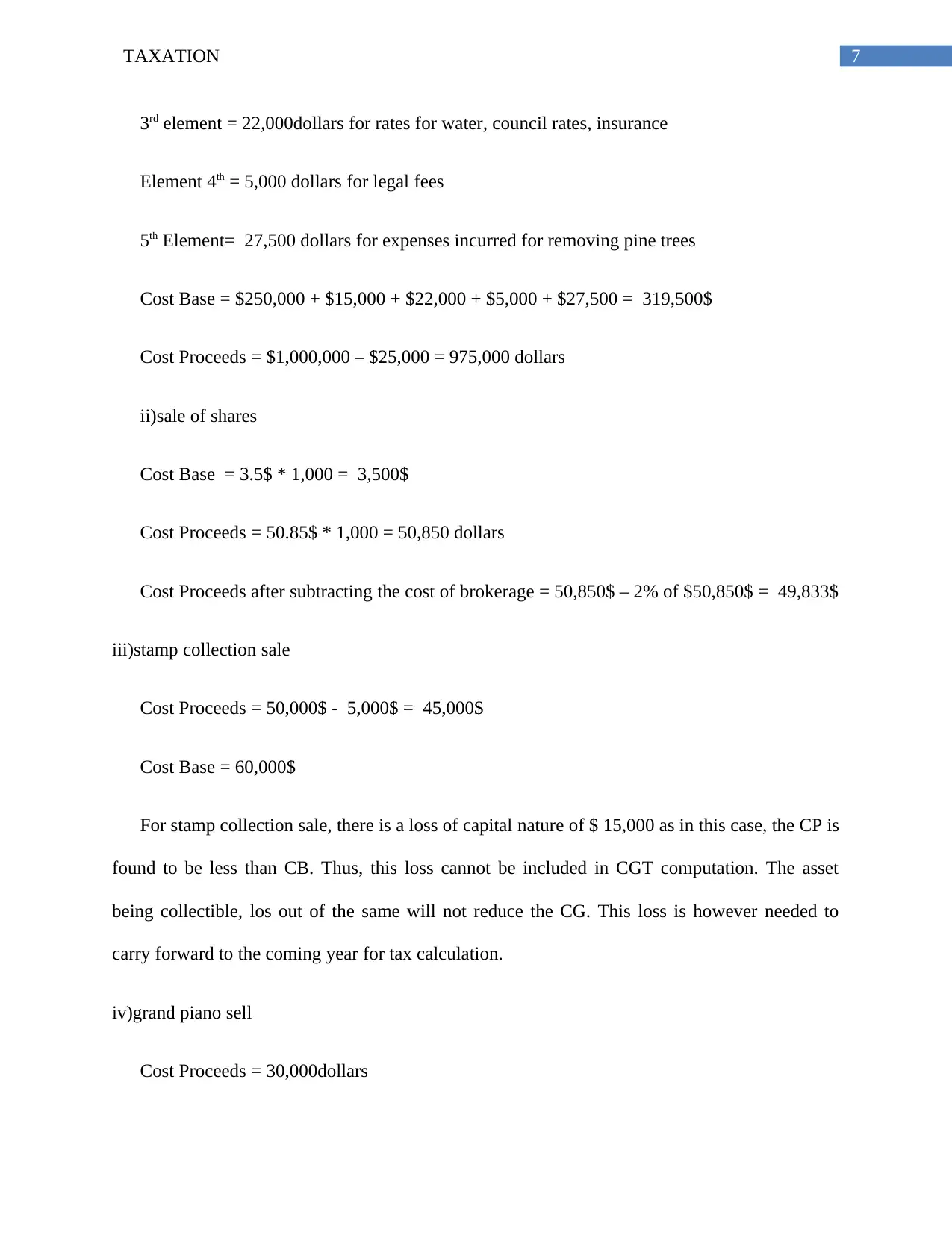
7TAXATION
3rd element = 22,000dollars for rates for water, council rates, insurance
Element 4th = 5,000 dollars for legal fees
5th Element= 27,500 dollars for expenses incurred for removing pine trees
Cost Base = $250,000 + $15,000 + $22,000 + $5,000 + $27,500 = 319,500$
Cost Proceeds = $1,000,000 – $25,000 = 975,000 dollars
ii)sale of shares
Cost Base = 3.5$ * 1,000 = 3,500$
Cost Proceeds = 50.85$ * 1,000 = 50,850 dollars
Cost Proceeds after subtracting the cost of brokerage = 50,850$ – 2% of $50,850$ = 49,833$
iii)stamp collection sale
Cost Proceeds = 50,000$ - 5,000$ = 45,000$
Cost Base = 60,000$
For stamp collection sale, there is a loss of capital nature of $ 15,000 as in this case, the CP is
found to be less than CB. Thus, this loss cannot be included in CGT computation. The asset
being collectible, los out of the same will not reduce the CG. This loss is however needed to
carry forward to the coming year for tax calculation.
iv)grand piano sell
Cost Proceeds = 30,000dollars
3rd element = 22,000dollars for rates for water, council rates, insurance
Element 4th = 5,000 dollars for legal fees
5th Element= 27,500 dollars for expenses incurred for removing pine trees
Cost Base = $250,000 + $15,000 + $22,000 + $5,000 + $27,500 = 319,500$
Cost Proceeds = $1,000,000 – $25,000 = 975,000 dollars
ii)sale of shares
Cost Base = 3.5$ * 1,000 = 3,500$
Cost Proceeds = 50.85$ * 1,000 = 50,850 dollars
Cost Proceeds after subtracting the cost of brokerage = 50,850$ – 2% of $50,850$ = 49,833$
iii)stamp collection sale
Cost Proceeds = 50,000$ - 5,000$ = 45,000$
Cost Base = 60,000$
For stamp collection sale, there is a loss of capital nature of $ 15,000 as in this case, the CP is
found to be less than CB. Thus, this loss cannot be included in CGT computation. The asset
being collectible, los out of the same will not reduce the CG. This loss is however needed to
carry forward to the coming year for tax calculation.
iv)grand piano sell
Cost Proceeds = 30,000dollars
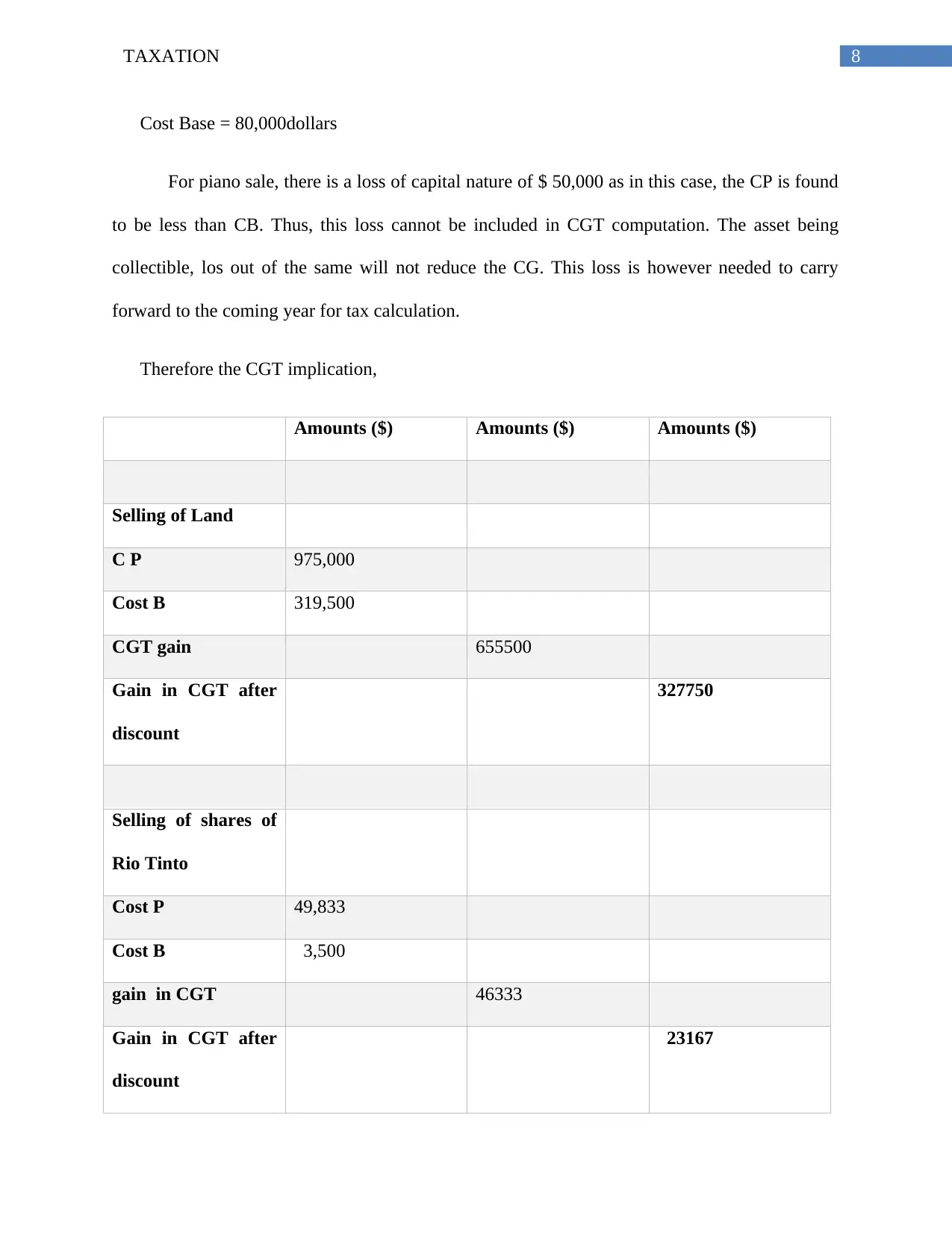
8TAXATION
Cost Base = 80,000dollars
For piano sale, there is a loss of capital nature of $ 50,000 as in this case, the CP is found
to be less than CB. Thus, this loss cannot be included in CGT computation. The asset being
collectible, los out of the same will not reduce the CG. This loss is however needed to carry
forward to the coming year for tax calculation.
Therefore the CGT implication,
Amounts ($) Amounts ($) Amounts ($)
Selling of Land
C P 975,000
Cost B 319,500
CGT gain 655500
Gain in CGT after
discount
327750
Selling of shares of
Rio Tinto
Cost P 49,833
Cost B 3,500
gain in CGT 46333
Gain in CGT after
discount
23167
Cost Base = 80,000dollars
For piano sale, there is a loss of capital nature of $ 50,000 as in this case, the CP is found
to be less than CB. Thus, this loss cannot be included in CGT computation. The asset being
collectible, los out of the same will not reduce the CG. This loss is however needed to carry
forward to the coming year for tax calculation.
Therefore the CGT implication,
Amounts ($) Amounts ($) Amounts ($)
Selling of Land
C P 975,000
Cost B 319,500
CGT gain 655500
Gain in CGT after
discount
327750
Selling of shares of
Rio Tinto
Cost P 49,833
Cost B 3,500
gain in CGT 46333
Gain in CGT after
discount
23167
⊘ This is a preview!⊘
Do you want full access?
Subscribe today to unlock all pages.

Trusted by 1+ million students worldwide
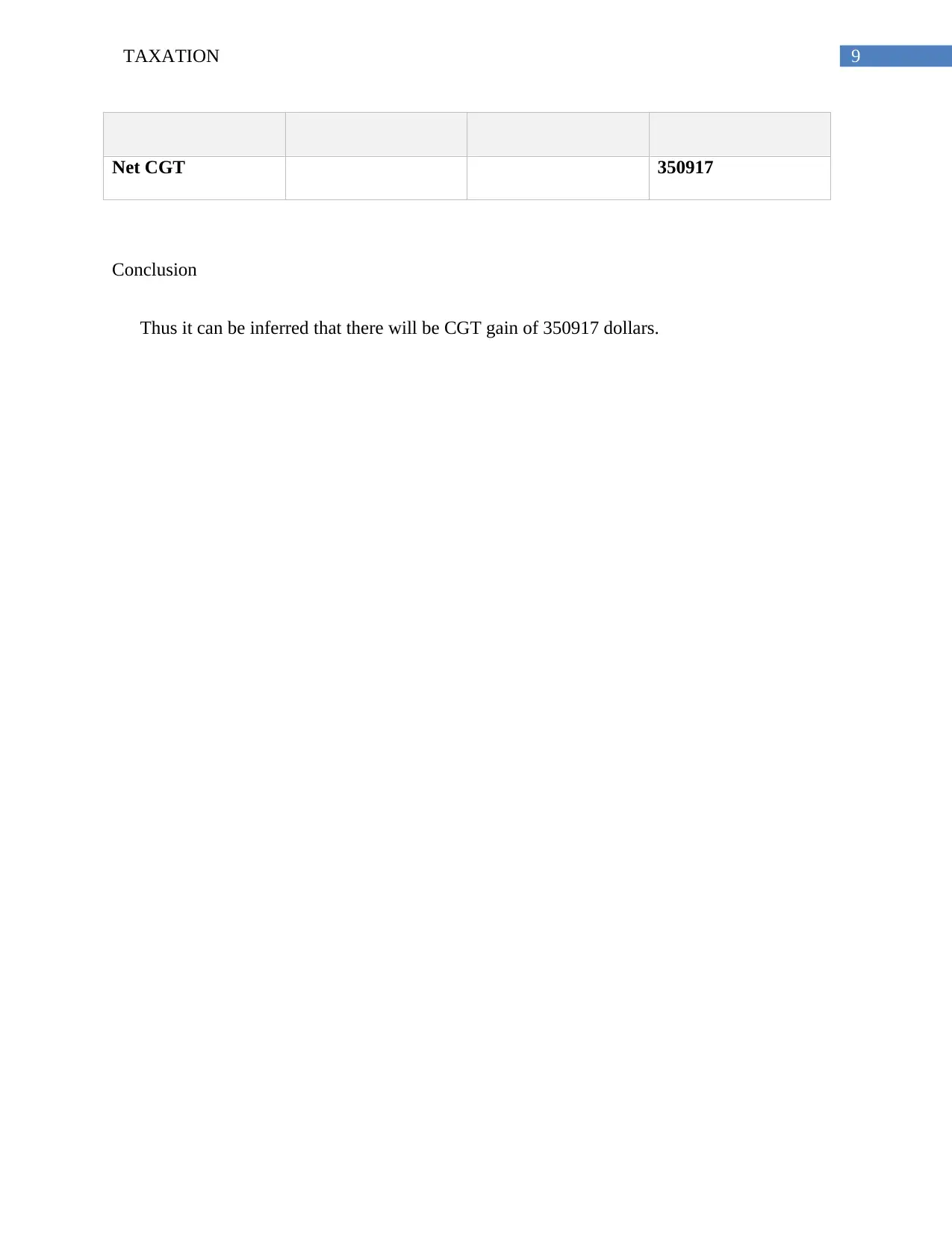
9TAXATION
Net CGT 350917
Conclusion
Thus it can be inferred that there will be CGT gain of 350917 dollars.
Net CGT 350917
Conclusion
Thus it can be inferred that there will be CGT gain of 350917 dollars.
Paraphrase This Document
Need a fresh take? Get an instant paraphrase of this document with our AI Paraphraser
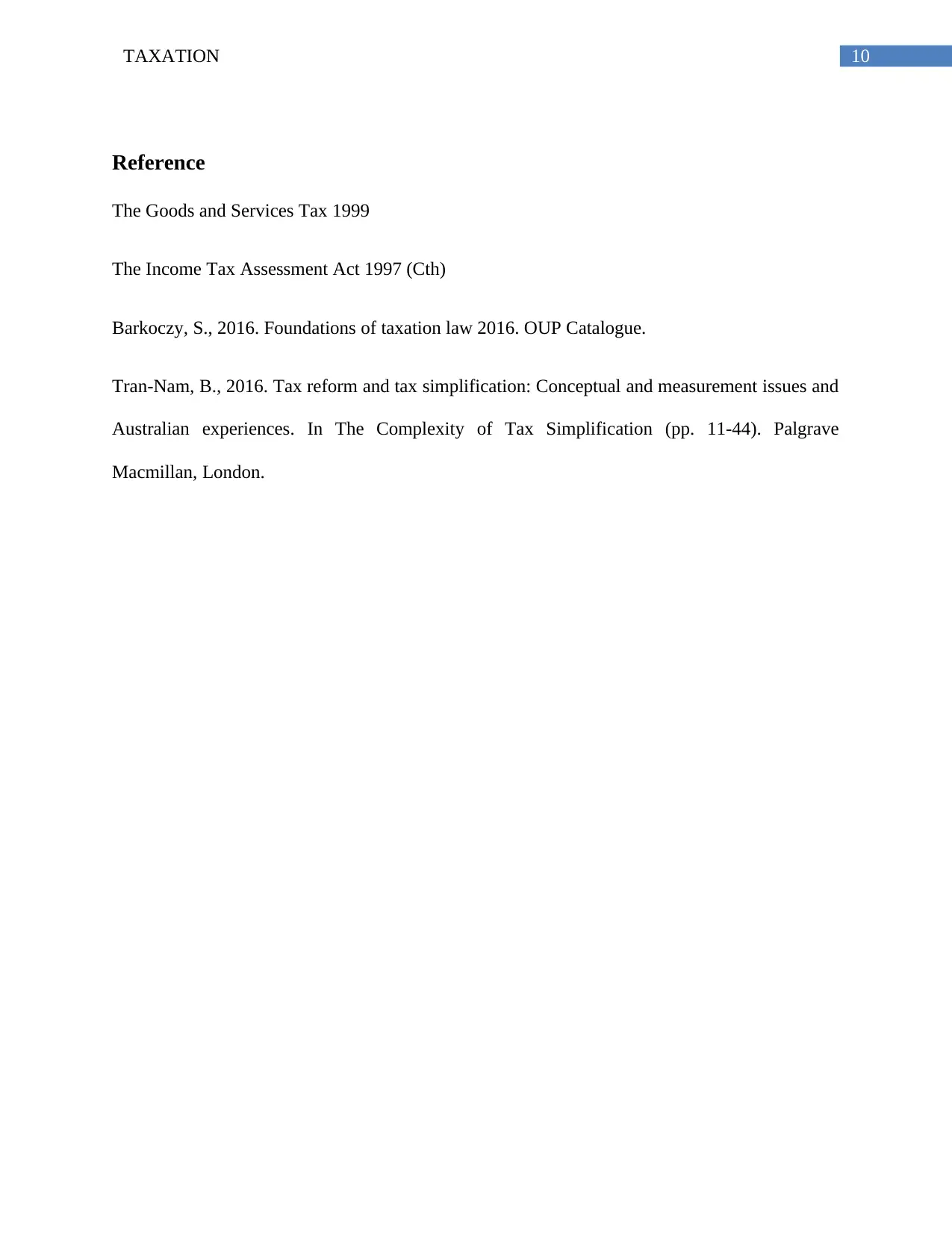
10TAXATION
Reference
The Goods and Services Tax 1999
The Income Tax Assessment Act 1997 (Cth)
Barkoczy, S., 2016. Foundations of taxation law 2016. OUP Catalogue.
Tran-Nam, B., 2016. Tax reform and tax simplification: Conceptual and measurement issues and
Australian experiences. In The Complexity of Tax Simplification (pp. 11-44). Palgrave
Macmillan, London.
Reference
The Goods and Services Tax 1999
The Income Tax Assessment Act 1997 (Cth)
Barkoczy, S., 2016. Foundations of taxation law 2016. OUP Catalogue.
Tran-Nam, B., 2016. Tax reform and tax simplification: Conceptual and measurement issues and
Australian experiences. In The Complexity of Tax Simplification (pp. 11-44). Palgrave
Macmillan, London.
1 out of 11
Related Documents
Your All-in-One AI-Powered Toolkit for Academic Success.
+13062052269
info@desklib.com
Available 24*7 on WhatsApp / Email
![[object Object]](/_next/static/media/star-bottom.7253800d.svg)
Unlock your academic potential
Copyright © 2020–2025 A2Z Services. All Rights Reserved. Developed and managed by ZUCOL.





